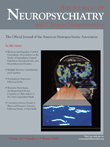A Squint of Brain: A Capgras Syndrome Variant
To the Editor: Capgras Syndrome is a delusional disorder which occurs whenever the patient believes that people close to him have been replaced by duplicates. We describe a variant of Capgras Syndrome, which probably relates to dementia with Lewy bodies.
Case Report
Mr. W, a right-handed 83-year-old retired businessman, presented with a 3-year history of impaired memory, topographical disorientation, fluctuating vigilance, bradykinesia, and nightmares with jerky movements. He developed a unique visual hallucination of a woman physically indistinguishable from his wife and whom he called “She.” Mr. W reported that he knew “She,” his main economic adviser and friend, for many years, but that they had never been lovers or married. He wished to cuddle her, felt loved by her, and was delighted to have her around.
Mr. W affirmed that “She” was real although he had never heard her voice. On several occasions, the patient was found talking to “She.” He asked her, “Where is my wife?” While entering the car, he would say “Let me find some place between you.”
However, he never touched his wife, mistaking her for “She,” nor did he feel as if it were “She” touching him when his wife was doing so.
Neurological examination revealed mild symmetric parkinsonism, normal visual acuity and ocular movements, and no cortico-spinal or cerebellar signs. Cognitive examination revealed severe loss of insight, bradypsychism, temporal disorientation, retrograde and anterograde memory deficits with perturbed recognition and intrusions, proper name anomia, constructive apraxia, and visual agnosia (difficult recognition of overlapped figures but not prosopagnosia). Mini-Mental State Examination (MMSE) score was 20 and no symptoms of anxiety or depression were reported. Finally, Mr. W fulfilled consensus criteria for diagnosis of probable dementia with Lewy bodies. 1
Magnetic resonance imaging (MRI) showed symmetric cortical atrophy, slightly predominant on the frontal and occipital lobes. [ 18 F]fluorodeoxyglucose positron emission tomography (PET) scan revealed bilateral hypometabolism (predominantly on the left hemisphere) of the lateral and medial temporal regions, fusiform and parahippocampal gyri, and peritemporal fronto-orbital areas.
Comment
The hallucinatory experience of Mr. W has the salient attribute of the Capgras syndrome, i.e., the misidentification of a person close to him. Features unique to this report are that the delusion was strictly limited to the visual modality, it did not encroach upon the patient’s wife but upon a visual hallucination of her, and that this misperception generated a convivial reaction.
Actually, Mr. W’s symptoms seem to correspond to a variant of the Capgras syndrome for which pathogenic mechanisms that are specific to dementia with Lewy bodies possibly intervene.
Hence, dementia with Lewy bodies manifests with early impairment of visuo-perceptive abilities and with complex visual hallucinations, 2 which have been related to the involvement of occipital regions. 3 , 4
In healthy individuals, complex visual information binds with preset memories and stored emotional attributes to produce a unified, meaningful, stable, and real image of the world. 5 It is conceivable that, for Mr. W, cognitive deficits specific to dementia with Lewy bodies (loss of insight, impaired attention and reality-checking, control deficit over intrusive memories, and visual agnosia) uncoupled visual inputs from regular cognitive and emotional processing.
As suggested by PET images, dysfunction of limbic areas could be a key mechanism of this “squint of brain.”
1 . McKieth IG, et al. Diagnosis and management of dementia with Lewy Bodies: third report of the DLB Consortium. Neurology 2005; 65:1863–1872Google Scholar
2 . Klatka LA, et al: Psychiatric features in diffuse Lewy Body disease: a clinicopathologic study using Alzheimer’s disease and Parkinson’s disease comparison groups. Neurology 1996; 47:1148–1152Google Scholar
3 . Harding AJ, et al: Visual hallucinations in Lewy body disease relate to Lewy Bodies in the temporal lobe. Brain 2002; 125:391–403Google Scholar
4 . Mori T, et al: Correlation of visual hallucinations with occipital rCBF changes by donepezil in DLB. Neurology 2006; 66:935–937Google Scholar
5 . Treisman A: Feature binding, attention and object perception. Philos Trans R Soc Lond B Biol Sci 1998; 353:1295–1306Google Scholar



